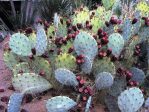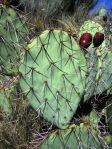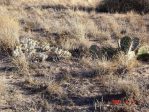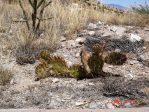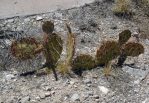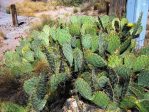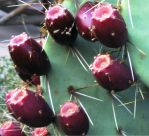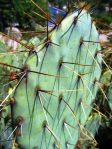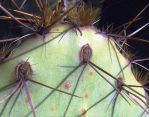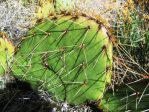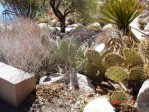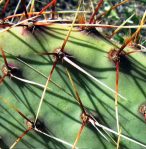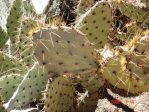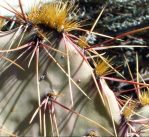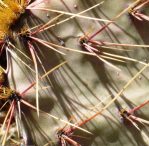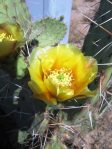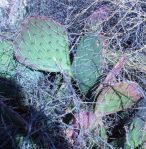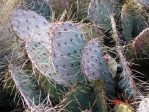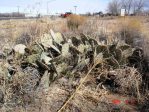
Griffiths, Annual Report Missouri Botanical Garden 21: 171, 1910
Original Description.
What is Opuntia wootonii?
Opuntia wootonii is a handsome pricklypear cactus from Mexico, western Texas, and New Mexico.
Details
O. wootonii is spreading and ascending 0.5-1 m tall and up to 2 m wide. The plants are not prostrate, though primary branches may rest on the ground. Cladodes are large, widest at the middle, and narrowed (or pointed) at both ends; their shape is distinctive. Alternately, cladodes may be obovate. Cladodes are 14-18 cm wide and 25-30 cm long on mature plants. The spines are 0.5-6 cm long may be longer on the oldest growth. Areoles have 1 -3(6) spines. The spines may be semi-erect or mostly spreading outwards. Spines have light tips that quickly darken to reddish-brown, chestnut, or even darker at the base.
Flowers are yellow.
Ploidy is unknown.
Other Notes
Typical O. wootonii specimens from south-central New Mexico, or the greater El Paso, Texas area are easily differentiated from other Opuntia by spine characteristics. They have chestnut-brown, long spines and are handsome plants. However, more northerly representatives (eg, Belen) of this mostly NM species are less spiny. Thus, two forms grade into each other: long-spined and short-spined.
It turns out that there are long-spined plants in the near-desert environments along the west bases of the Sacramento and Guadalupe Mountains (short-spined plants are much more abundant). Long-spined plants also occur near the base of the San Andreas Mountains (both sides) and are on the east side of the Organ Mountains. There are also long-spined plants along the west side of the Manzano Mountains, but they are not as spectacular and the spines are duller and a bit more brown.
The species ranges from Rio Rancho in Sandoval County, New Mexico, to at least the Delaware Mts in Texas, and probably they are in the Sierra Juarez Mts too. In the Guadalupe, Sacramento, Organ, and Manzano Mts, the plants are quite common but mostly as the short-spined form at elevations above the deserts (and they may be confused with other species there). The authors expect the species to be abundant in some of the northern mountains of Mexico, particularly in Coahuila. They may be in most of the trans-Pecos Texas mountains. Likely they are in the Chisos and Davis Mts.
There are plants very similar to this species (long-spined, but duller spine colors) in the Florida Mountains near Deming, New Mexico, and what may be the short-spined form occurs on the south side of the White Mountains and along the Mogollon Rim in Arizona as far west as Prescott.
The specific epithet, wootonii, is apparently derived from wootton, which means a place by the woods.

